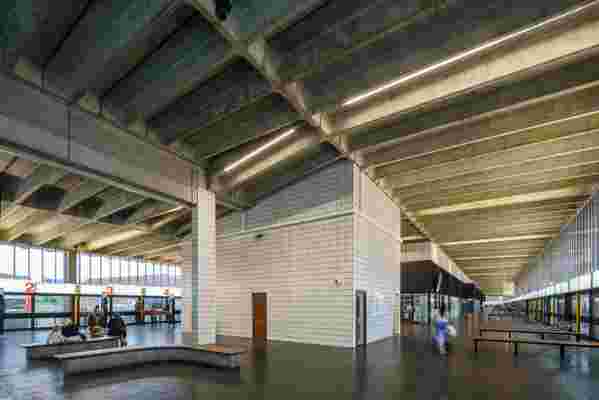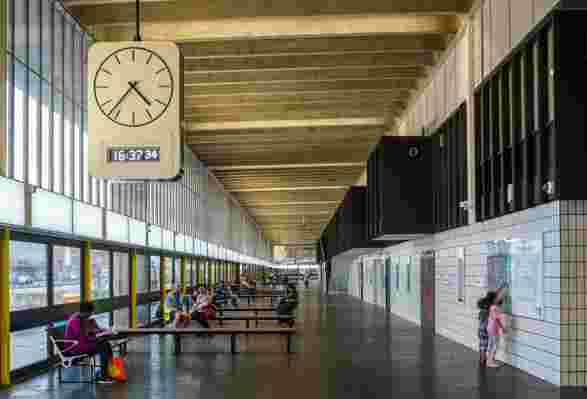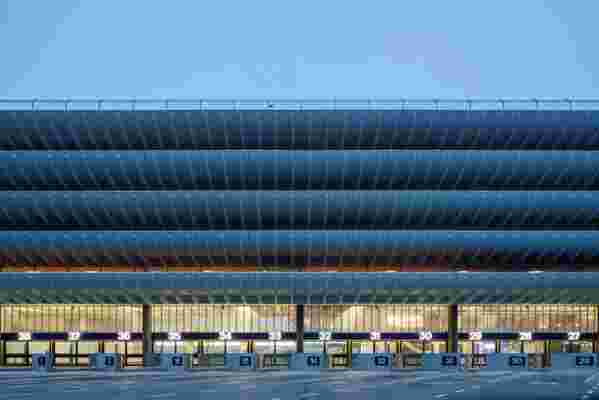This Is Why a Bus Station Has Just Been Awarded a Major Architectural Prize
The 2021 World Monuments Fund/Knoll Modernism Prize has been awarded to John Puttick Associates in recognition of its conservation of Preston Bus Station, a brutalist masterpiece in Lancashire, northern England. Since 2008, the biennial prize has recognized innovative solutions to preserving threatened modern architecture. Previously honored projects include the Vyborg Library in Leningrad, Russia; Hizuchi Elementary School in Yawatahama City, Japan; and the Karl Marx School in the Paris suburb of Villejuif.
Preston Bus Station is the largest project to receive the WMF/Knoll Prize, though, and the first at the scale of regional infrastructure. “While transport interchanges can often be dreary and confusing places, the bus station demonstrates how creating generous and humane spaces can help to improve people’s day-to-day lives,” JPA founder and director John Puttick told Architectural Digest .

Inside of the station, which was originally built in the late 1960s.
“It is very encouraging that the award has been given to a public building of this type, highlighting the contribution architecture can make to the public realm.” The station was originally designed in 1968 by Keith Ingham and Charles Wilson of the Building Design Partnership (now BPD) to be a transit hub for central Lancashire. When it opened its doors a year later, the 560-foot-long structure was Europe’s largest bus depot.
It was also a prime example of the brutalist architecture movement popular in the post-WWII era, with an exposed reinforced concrete shell and distinctive curved fins. At the time, Preston was tipped to be a thriving economic center, and the station was expected to accommodate a booming influx of commuters and tourists. Instead, over the decades, it fell into disrepair.
By 2012, the station was slated for demolition—a move highly criticized by architectural preservation organizations like the Twentieth Century Society, which described it in a petition as “one of the most significant brutalist buildings in the U.K.” That same year Preston Bus Station was included on the World Monuments Watch’s list of threatened heritage sites.

John Puttick Associates oversaw a major renovation of the station, which restored the rubber floors by Italian tire brand Pirelli, buffed out scuffs in the Iroko hardwood benches, and even brought back the Helvetica typeface signage.
Efforts to save the building from the wrecking ball resulted in it being granted Grade II listed status by Historic England in 2013. Five years later, Puttick’s firm oversaw a major renovation of the station, which restored the rubber floors by Italian tire brand Pirelli, buffed out scuffs in the Iroko hardwood benches, and even brought back the Helvetica typeface signage. In addition, the building’s layout was reworked to be more pedestrian-focused and connect the station with the rest of the city. “The careful approach resulted not only in the meticulous restoration of the site, but also in renewing the expression of civic pride that the Preston Bus Station represented in its early days,” WMF said in a statement.
The organization’s president, Bénédicte de Montlaur, praised the project for underscoring the “power of preservation as a positive force in society.” And not just aesthetically: With over 10,000 bus departures every week, De Montlaur added, Putnam Bus Station “now helps minimize the significant carbon footprint of commuting in the face of climate change.”
“The complex’s respectful restoration represents not only appreciation of the modernist commitment to creating dignified monuments for basic civic functions, but the 21st century’s need to adopt sustainable rehabilitation of inherited structures,” architectural historian Barry Bergdoll, jury chair for this year’s prize, said in the release. “It is at once an achievement for Lancashire and an exemplar for other cities.”

The building is a prime example of brutalist architecture.
Puttick said the award also reflects a shift in attitudes toward brutalist architecture, which had been denigrated in more recent decades. “Appreciation for brutalist buildings was something of a niche preoccupation until only a few years ago,” Puttick explains. “And, in many cases, the organizations responsible for such structures did not necessarily value them.”
The value of brutalist structures isn’t just in their aesthetics, he added, but in their generous provision of space and use of long-lasting materials. “Hopefully the award will encourage the further re-use of brutalist buildings at a time when conserving the embodied energy of existing structures is environmentally very significant,” Puttick says.
The prize will be presented during a ceremony at AIA New York, Center for Architecture in New York on December 14, 2021.